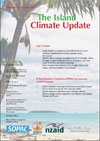10 March 2008
An overview of the present climate in the tropical South Pacific Islands, with an outlook for the coming months, to assist in dissemination of climate information in the Pacific region.
Number 90 – March 2008
February’s climate
- South Pacific Convergence Zone (SPCZ) extends from northeast of Australia towards New Caledonia and northeast of New Zealand, displaced well southwest of normal
- Suppressed convection exists from Western Kiribati to Eastern Kiribati and about the Equator with low rainfall, especially near Nauru
- Below normal rainfall for several stations in Samoa, but very high rainfall in New Caledonia, and one record high recorded in Tonga.
El Niño/Southern Oscillation (ENSO) and seasonal rainfall forecasts
- The strong La Niña episode present in the Pacific has reached maturity, and the event is expected to persist into the Southern Hemisphere autumn
- Suppressed convection and average or below average rainfall is very likely along the equatorial Pacific encompassing the region from Western Kiribati to Eastern Kiribati, the Solomon Islands, the Society Islands, Tuamotu, and the Marquesas Islands. Near or below average rainfall is likely for the Northern Cook Islands and Wallis & Futuna, while average rainfall is likely for Samoa, Tonga, and Pitcairn Island.
- Enhanced convection is likely to continue along a southwest displaced SPCZ with average or above average rainfall for New Caledonia, the Southern Cook Islands, and the Austral Islands, while Papua New Guinea, Fiji, and Niue are expected to receive near or above average rainfall.

A complete copy of The Island Climate Update is available as an Adobe Acrobat PDF file. This does not contain any extra information over that obtained by clicking on the individual items above.
To view the PDF file, you'll need Adobe Acrobat Reader, which you can download free from Adobe.
